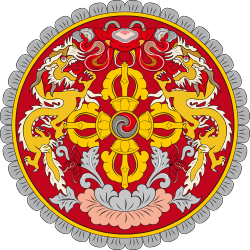2013 Bhutanese National Assembly election
National Assembly elections were held in Bhutan on 31 May and 13 July 2013.[1] The result was a victory for the opposition People's Democratic Party (PDP), which won 32 of the 47 seats. The elections were the second general elections to occur in Bhutan since former King Jigme Singye Wangchuck ushered in democratic reforms.[2]
| |||||||||||||||||||||||||||||||||||||
All 47 seats in the National Assembly 24 seats needed for a majority | |||||||||||||||||||||||||||||||||||||
|---|---|---|---|---|---|---|---|---|---|---|---|---|---|---|---|---|---|---|---|---|---|---|---|---|---|---|---|---|---|---|---|---|---|---|---|---|---|
| Turnout | 66% | ||||||||||||||||||||||||||||||||||||
| |||||||||||||||||||||||||||||||||||||
 Results of the Bhutanese elections. | |||||||||||||||||||||||||||||||||||||
| |||||||||||||||||||||||||||||||||||||
 |
|---|
| This article is part of a series on the politics and government of Bhutan |
|
Monarchy |
|
Government |
Background
By law, the National Assembly is required to be reconstituted within 90 days of its previous term expiring. As the term of the Assembly elected in 2008 expired on 20 April 2013, this meant that the new Assembly would need to have been elected by 20 July.[3]
Electoral system
The election was held in two rounds. In the first round every party contested all 20 Dzongkhags (the administrative and judicial districts of Bhutan). The parties with the two highest vote tallies progressed to the second round, in which they put forward candidates in each of the 47 National Assembly constituencies.[1] In the first round of the elections, the Bhutan Peace and Prosperity Party had received roughly 40% of votes and the People's Democratic Party receiving approximately 30%, with two other parties sharing the other 30% of the votes.[2]
A total of 381,790 voters were registered for the election.[4] The election date for the first round was made a public holiday, with all businesses required to close on the day.[5] Over 4,000 electronic voting machines were provided by India for the election.[6]
Campaign
Four parties contested the election; the ruling Bhutan Peace and Prosperity Party (DPT), the main opposition People's Democratic Party, and two new parties, Druk Nymrub Tshogpa and Druck Chirwang Tshogpa.[7] A fifth party, the Bhutan Kuen-Nyam Party, attempted to participate in the election, but failed to field a university-educated candidate in Gasa District in the northern part of the country. Consequently, the Bhutanese Elections Commission disqualified the party, even though each of the four other parties had made official requests to the commission to allow the Bhutan Kuen-Nyam Party to participate.[2] The head of the party, Sonam Tobgay, stated that "Four parties appealing for the fifth party, who couldn’t qualify, is something unprecedented universally and internationally, something special and noble."[2] The DPT campaigned for the support of rural communities having improved access to roads, mobile phone networks and electricity during its tenure.
Ties with India had recently come under strain after it cut subsidised cooking gas and kerosene to Bhutan, viewed as a punishment for developing ties with China.[8] This tripled the cost of fuel and made relations between the two neighbours a major electoral issue.[9] The consequent rise in fuel prices was coupled with a credit crunch and import restrictions after the country ran short of foreign exchange reserves of the Indian rupee.[10] The People's Democratic Party had campaigned on a platform of stronger relations with India and a decentralisation of powers, devolving control through local government.[8]
Results
The voting process was a challenge due to the mountainous terrain as officials had to trek for seven days to set up some polling stations.[10]
As a result of the election, Tshering Tobgay is expected to be named Prime Minister of the new government,[8] to form once a 10-day "petition period" for electoral complaints to be heard has finished.[6] Three women were elected, with Dorji Choden of the PDP expected to be Bhutan's first female minister.[6]
 | |||||||||
| Party | First round | Second round | |||||||
|---|---|---|---|---|---|---|---|---|---|
| Votes | % | Votes | % | Seats | +/– | ||||
| People's Democratic Party | 68,650 | 32.53 | 138,760 | 54.88 | 32 | +30 | |||
| Bhutan Peace and Prosperity Party | 93,949 | 44.52 | 114,093 | 45.12 | 15 | −30 | |||
| Druk Nyamrup Tshogpa | 35,962 | 17.04 | |||||||
| Druk Chirwang Tshogpa | 12,457 | 5.90 | |||||||
| Total | 211,018 | 100 | 252,853 | 100 | 47 | 0 | |||
| Registered voters/turnout | 381,790 | 55.27 | 381,790 | 66.23 | |||||
| Source: Electoral Commission of Bhutan a, b c | |||||||||
Reaction and analysis
Prime Minister of India Manmohan Singh sent the PDP a message of congratulations, assuring Bhutan of India's "steadfast and unflinching support."[8]
The PDP victory was considered an upset by the media.[10]
Notes and references
- Notification on Second Parliamentary Elections 2013: National Assembly Archived 7 September 2013 at the Wayback Machine Election Commission of Bhutan
- Ahmad, Omair (15 June 2013). "Experiments With Democracy in Bhutan". The New York Times. Retrieved 19 July 2013.
- The likely assembly election periods Archived 22 April 2016 at the Wayback Machine KCD Productions
- Nearly 400,000 voters for National Assembly’s elections BBS News, 5 May 2013
- Second Parliamentary Elections 2013: National Assembly Poll Day for the Primary Round Archived 5 November 2013 at the Wayback Machine Election Commission of Bhutan, 28 May 2013
- "Bhutan's Election Commission completes polls process, hands over MP list to King". DNA India. Retrieved 14 July 2013.
- "Bhutan votes in key elections". BBC. 31 May 2013.
- "Bhutan opposition party wins parliament election after calling for stronger ties with India". The Washington Post. 14 July 2013. Retrieved 14 July 2013.
- Ahmad, Omair. "Bhutan's second general elections: A big win for democracy". The Times of India. The Economic Times. Retrieved 15 July 2013.
- "Bhutan's opposition party scores upset win". Al Jazeera. 13 July 2013. Retrieved 15 July 2013.

.jpg)